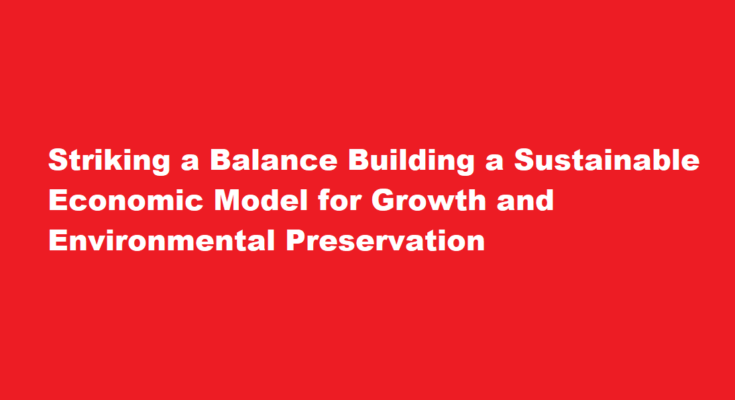In an era marked by pressing environmental challenges and growing concerns about climate change, the need for an economic model that harmonizes both growth and environmental preservation has become more urgent than ever. Achieving this delicate balance requires innovative thinking, collaborative efforts, and a holistic approach to policy making and business practices. This article delves into the key strategies and principles for establishing a sustainable economic model that prioritizes both economic growth and environmental well-being.
Rethinking Growth – Green GDP and Beyond
Traditional measures of economic growth, such as Gross Domestic Product (GDP), fail to account for the negative externalities on the environment and natural resources. To create a sustainable economic model, it is crucial to shift towards a “green GDP” approach. This involves valuing natural capital and ecosystem services, factoring in the costs of environmental degradation, and incorporating them into economic indicators.
Circular Economy – Redefining Consumption and Production
One of the cornerstones of a sustainable economic model is the adoption of a circular economy. This model emphasizes reducing waste, reusing materials, and recycling products to minimize the strain on resources and ecosystems. By encouraging product design that prioritizes longevity and repairability, as well as incentivizing businesses to adopt closed-loop production processes, a circular economy fosters sustainable growth while minimizing environmental impact.
Incentivizing Innovation – Green Technologies and Research
Investment in research and development of green technologies is pivotal to achieving a sustainable economic model. Governments and industries should collaborate to provide incentives for the development and deployment of renewable energy sources, sustainable agriculture practices, and clean transportation systems. This not only stimulates economic growth but also reduces the dependence on finite resources and lowers pollution levels.
Regulatory Frameworks – Aligning Profit with Planet
Robust regulatory frameworks are essential to ensure that economic activities align with environmental preservation goals. Governments must enact and enforce laws that incentivize sustainable practices, discourage harmful activities, and impose penalties for environmental violations. Carbon pricing mechanisms, emission standards, and regulations promoting responsible resource extraction are crucial steps toward fostering economic growth within planetary boundaries.
Investing in Natural Capital – Biodiversity and Ecosystem Services
Preserving biodiversity and protecting ecosystem services contribute significantly to long-term economic sustainability. Governments and businesses should recognize the value of intact ecosystems in providing essential services like clean water, pollination, and climate regulation. Investments in nature-based solutions, such as reforestation and wetland restoration, offer a dual benefit of boosting economic growth and safeguarding the environment.
Green Finance and Responsible Investment
Transitioning to a sustainable economic model requires significant financial resources. Green finance, which involves directing investments toward environmentally friendly projects, plays a pivotal role. By incorporating environmental, social, and governance (ESG) criteria into investment decisions, businesses and investors can drive positive change while also ensuring healthy returns.
Education and Awareness – Fostering a Mindset Shift
Changing the economic paradigm necessitates a cultural shift in how societies view growth and prosperity. Education and awareness campaigns can promote sustainable consumption patterns, encouraging individuals to make environmentally conscious choices. By instilling a sense of responsibility and connection to the environment, future generations can drive demand for businesses that prioritize both growth and sustainability.
Collaboration and Multilateralism
Addressing the complex interplay between economic growth and environmental preservation requires global collaboration. Governments, businesses, civil society, and international organizations must work together to set common goals, share best practices, and coordinate efforts to achieve sustainable development. Multilateral agreements like the Paris Agreement on climate change exemplify the power of collective action in addressing shared challenges.
FREQUENTLY ASKED QUESTIONS
Should we prioritize economic growth or environmental sustainability?
Promoting growth, alleviating poverty, and protecting the environment may be mutually supportive objectives in the long run, but they are not always compatible in the short run. Poverty is a major cause of environmental degradation , and economic growth is thus necessary to improve the environment.
How can environmental sustainability and economic growth coexist?
Reducing energy and resource usage is how businesses can save money while indirectly saving the environment. Increasing Productivity. Upgrading technology and tools decrease inefficiency in the workplace. Reduced Waste.
In conclusion, the imperative to establish a sustainable economic model that balances growth with environmental preservation is clear. By redefining traditional economic metrics, embracing circular economy principles, incentivizing innovation, enacting robust regulations, investing in natural capital, promoting responsible investment, fostering education, and prioritizing collaboration, societies can pave the way for a future where economic prosperity and ecological health coexist harmoniously. The path to this future requires collective determination and a steadfast commitment to leaving a flourishing planet for generations to come.



